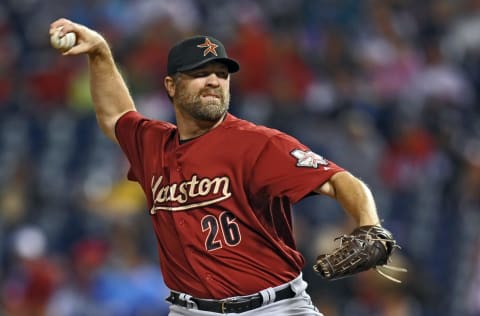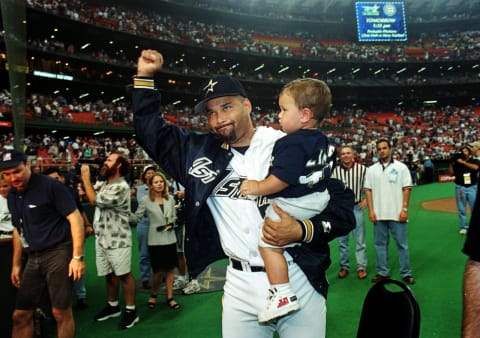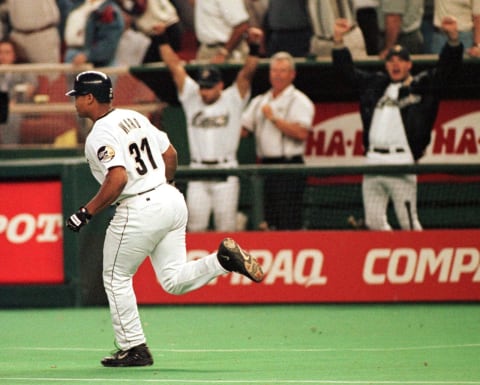Astros: Revisiting 1996 Brad Ausmus trade with Tigers

The Houston Astros swung a big trade with the Tigers in 1996 to acquire Brad Ausmus and others, and its impact is impressive.
Following the 1996 season, the Houston Astros were looking to make some changes. They were coming off an 82-80 season in the final year under manager Terry Collins and had replaced him with franchise legend Larry Dierker. They also swung a big trade in December to acquire Brad Ausmus and others from Detroit.
On December 10, GM Gerry Hunsicker sent Doug Brocail, Brian Hunter, Todd Jones and Orlando Miller to the Tigers in exchange for Ausmus, Jose Lima, Trever Miller, C.J. Nitkowski and Daryle Ward. There aren’t many nine-player trades, and even fewer have all nine players play in the major leagues at one time or another.
This trade sent some key contributors to the 1996 team away, but it also brought in a few guys who would be instrumental in the team’s future success. The following season, the Astros won the NL Central title for the first time, the first of four division titles in a five-year span.
Interestingly, two of the players the Astros gave up in this trade eventually returned to Houston later in their careers. Two of the players the Astros received would end up being traded away and then also returning again.
If nothing else, the trade shook things up a little bit, bringing some new faces to town as the team was ready to move forward with a new manager. It’s tough to call this trade a big win for either side in hindsight, but it’s interesting nonetheless.

What the Astros Gave Up
Brocail came to Houston along with Derek Bell and others in the big Dec. 1994 trade that saw a group including Ken Caminiti and Steve Finley head to San Diego. He’d spent two unspectacular seasons in the Astros bullpen prior to the trade but turned in three excellent seasons for the Tigers immediately thereafter.
Brocail would have a three-season absence from the majors thanks to injuries, but he returned to the Astros for the final two seasons of his playing career. He also served as the club’s pitching coach for a time and currently serves as the Orioles pitching coach.
The 25-year-old Hunter was coming off his first season as a full-time regular. He hit .276/.297/.363 with 35 stolen bases as the Astros everyday center fielder. He led the majors with 74 steals in 1997 for the Tigers, but hit only .261/.317/.342 for Detroit in two-plus seasons. He bounced around between several teams before ending his career as a reserve with the Astros in 2002 and 2003.
Jones had established himself as a solid, if unspectacular, reliever. Aged 28 at the time of the trade, he’d posted 39 saves and a 3.27 ERA in four seasons for the Astros. He went on to save 235 games in eight seasons with the Tigers in two separate stints. All told, he finished with 319 saves and a career 3.97 ERA.
Orlando Miller was the Astros’ everyday shortstop in 1996, hitting .256/.291/.417 with 15 homers in his age-25 season. He hit only .234/.289/.369 for the Tigers in 1997 and never played in the majors again, spending the next three seasons in the minors before leaving the game.

What the Astros Got
At the time of the trade, Ausmus was a 27-year-old catcher who put up a strong 1995 season but struggled at the plate in a 1996 season split between the Padres and Tigers. The Astros needed an upgrade behind the dish, and he provided that with solid defense and batting averages of .266 and .269 in two seasons.
Interestingly, the Astros traded Ausmus back to the Tigers along with Nitkowski prior to the 1999 season. Then Ausmus was traded back the Astros along with Brocail after the 2000 season. All told, he spent 10 seasons in Houston and won three Gold Glove Awards.
Lima was a young right-hander whose best major league season was 1996 in which he’d posted a 5.70 ERA. But he quickly blossomed into one of the franchise’s most beloved players, winning 16 games in 1998 and 21 games in 1999 as “Lima Time” took off. He wasn’t able to sustain the success, unfortunately, but that doesn’t take away from what he brought to this team.
Trever Miller actually didn’t pitch in the majors in 1997, but he returned in 1998 to post a 3.04 ERA out of the bullpen. He pitched to a 5.07 ERA in 1999 and then was traded to the Phillies prior to the 2000 season. He would return to Houston in 2006 and 2007 to put up a pair of solid seasons as a lefty specialist.
Nitkowski hadn’t found success in the majors yet and thus spent all of 1997 at Triple-A. But he posted a 3.77 ERA out of the Astros bullpen in 1998 before being shipped back to the Tigers along with Ausmus. He ultimately played for eight teams in a 10-season major league career.
Ward hadn’t yet made his major league debut, but finally did when he made four plate appearances in 1998. In the ensuing four seasons, he was a part-time first baseman/corner outfielder and pinch hitter extraordinaire, compiling a .269/.316/.465 line with 49 homers and 188 RBIs for the Astros. He was traded to the Dodgers prior to the 2003 season.

The Overall Verdict
This trade is a bit difficult to grade since pretty much everyone involved would be considered more of a role player. They had plenty of positive contributions, but none of them would be mistaken for a franchise cornerstone.
The Tigers clearly got the better side of Brocail in this deal, who turned in three excellent seasons immediately following the trade. They got some good work from Jones as well, who stepped in as the team’s closer right away. Hunter’s best season with the Tigers was his first, as his numbers declined after that; he was a threat on the bases but not enough of one at the plate.
Orlando Miller did practically nothing for the Tigers, so that’s a loss for them. The Astros really didn’t take a loss in this deal, as all five players they received played a positive role, at least to some degree. Trever Miller and Nitkowski’s contributions were minor, but they weren’t bad.
More from Climbing Tal's Hill
- Just how much better is the Houston Astros playoff rotation than the rest?
- Houston Astros: A Lineup Change to Spark Offense
- Astros prospect Hunter Brown throws 6 shutout innings in debut
- Always faithful Astros World Series champion Josh Reddick defends the title
- Michael Conforto declines Astros’ 2-year, $30 million offer
Ausmus and Ward were important parts of the Houston franchise for several seasons. Neither was an All-Star with the team, but they had their roles and played them well. Ausmus, in particular, spent several seasons alongside the Killer B’s in some of their best years.
Lima’s contributions may have been the best of this deal, and it wasn’t all about his on-field performance. He had two really strong seasons sandwiched between some rough ones, but those strong seasons were important in the team winning two of its division titles.
Off the field, he was a Houston celebrity, parlaying his “Lima Time” into some forays into music and a memorable television commercial. It’s hard to think of the late ’90s Astros without thinking about Lima, and he left his mark on the city as much as any player of the time.
So in the end, I’d say the Astros won this deal, though not by a great margin. Lima helps tip the balance in their favor, and that alone was reason enough for this trade to have happened. It helped set the stage for some memorable seasons in Houston.